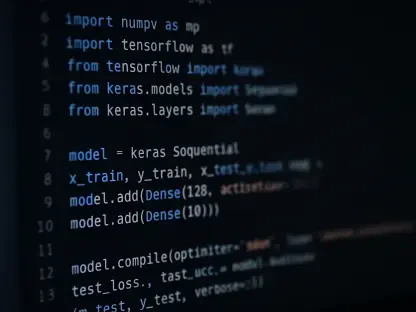Red Hat’s approach to open-source artificial intelligence (AI) diverges from idealistic aspirations of artificial general intelligence (AGI) and instead focuses on practical, enterprise-level applications. This aligns with the company’s long-standing commitment to open-source principles, acknowledging the current capabilities and limitations of AI while striving for attainable advancements that can benefit a broad user base. Central to this approach is the recognition of the unique challenges AI presents compared to traditional software, particularly concerning transparency and the definition of what constitutes “open-source AI.”
Navigating the Complex AI Landscape
The Financial Impact of AI
The financial impact of AI, especially highlighted by breakthrough programs such as China’s DeepSeek, which shook the industry’s foundations, underscores the transformative potential of AI technologies. Red Hat, being a leading provider of Linux-based solutions, understands this dynamic landscape and aims to navigate these complexities through a pragmatic mindset. This forward-thinking approach was further emphasized during the Linux Foundation Members Summit in November 2024. Here, Richard Fontana, Red Hat’s principal commercial counsel, discussed the significant issues surrounding the labeling of AI as open source.
Fontana’s remarks during a panel discussion shed light on the intricacies that AI brings to traditional open-source software models. Conventional open-source software relies heavily on the accessibility and transparency of its source code. However, AI complicates this paradigm with opaque training data and complex model weights, making it challenging to ascertain a clear definition of “open-source AI.” This raises questions about whether the concept of fully open-source AI is currently achievable or remains a utopian ideal requiring fundamental changes in how we approach AI transparency.
Challenges of Open-Source AI
The notion of fully open-source AI presents several significant challenges that differ notably from traditional open-source software practices. During his panel discussion, Fontana emphasized the ambiguity and impracticality associated with making training data entirely open for large language models (LLMs). The extensive resources and proprietary data required to train these models create an inherent conflict with the principles of open-source accessibility and transparency. This predicament questions if open-source AI, in its truest sense, is a feasible concept given the current technological and legal landscape.
This challenge is exacerbated by the trend of models being released under licenses that claim to be open but contain various restrictive provisions. Such practices dilute the core principles of open-source software, creating what Fontana refers to as “fake open-source programs.” An example he cited is Meta’s LLama, which claims to be open-source but deviates significantly from genuine open-source ideologies. This underscores the ongoing struggle to maintain transparency and openness in AI development while acknowledging the commercial and competitive realities that companies face today.
Addressing Transparency and Legal Concerns
The Issue of “Fake Open-Source Programs”
The proliferation of “fake open-source programs” has created a paradigm shift in how AI development is perceived in the tech industry. These models, released under licenses that masquerade as open-source, often come with restrictive provisions that limit true openness and accessibility. Fontana highlights Meta’s LLama as a key example, illustrating the dissonance between claimed openness and actual practice. This growing trend presents a significant challenge for Red Hat as it strives to align its AI development with authentic open-source principles, emphasizing the need for clear and genuinely open policies.
Red Hat’s challenge lies in reconciling the demand for transparency in AI development with the competitive and legal practicalities that companies face today. While the company strongly advocates for openness, the mandatory full disclosure of training data poses substantial risks in the current legal environment, where model creators could face increased scrutiny and targeting. Additionally, the issue of fair use of publicly available data further complicates the expectations around transparency, making it essential for Red Hat to strike a balance between transparency and legal protection.
Risks of Full Disclosure
While advocating for openness, Red Hat recognizes that mandating full disclosure of training data can pose significant risks, particularly in a legal environment that could potentially target model creators. The complexities of fair use regarding publicly available data add another layer of challenge, complicating the expectations around transparency in AI. Consequently, Red Hat’s strategy prioritizes practical steps toward AI reproducibility over the pursuit of full transparency, aiming for a more balanced approach that considers both ethical and practical implications.
This nuanced strategy is reflected in Red Hat’s emphasis on reproducibility and practicality in AI development. By promoting reproducible and accountable AI practices, the company seeks to foster a more transparent and ethically sound AI development culture. This approach acknowledges the limitations and risks associated with full transparency and instead focuses on creating a robust framework that prioritizes ethical considerations without compromising legal or competitive viability. Red Hat’s stance represents a pragmatic middle ground, striving for meaningful progress in AI transparency while addressing the real-world constraints faced by developers and organizations.
Promoting Practical AI Reproducibility
Open Models and Community-Driven Initiatives
Red Hat promotes practical AI reproducibility through the adoption of open models such as Granite LLMs and community-driven initiatives like InstructLab. Chris Wright, Red Hat’s Chief Technology Officer (CTO), articulates this approach by drawing parallels to the company’s legacy with Linux. He suggests that the same collaborative ethos that drove Linux’s success can be applied to AI development, emphasizing Red Hat’s commitment to avoiding vendor lock-in and ensuring that advancements in AI are accessible and beneficial to a broad audience.
Wright’s vision positions community-driven initiatives at the heart of Red Hat’s AI strategy. By encouraging collaboration and shared expertise, the company aims to harness the collective knowledge of the developer community to fine-tune and improve AI models. Initiatives such as InstructLab exemplify this approach, enabling developers to contribute to the refinement and customization of AI models. This strategy aligns with Red Hat’s broader mission to foster an inclusive and cooperative environment for AI development, ensuring that AI advancements are not only technically sound but also ethically responsible and accessible to all.
Structural Differences Between AI and Traditional Software
Wright acknowledges the fundamental structural differences between AI models and traditional software development. Unlike traditional software, defined primarily by its source code, AI models are characterized by their model weights—the parameters that govern how the model interprets and processes data. These weights result from extensive training processes that involve numerous training data sets, making the development and improvement of AI models dependent on model weight adjustments and fine-tuning rather than direct manipulation of the original training data.
This distinction highlights the unique challenges and opportunities in AI development, necessitating a tailored approach that considers the specificities of AI models. Fontana echoes this sentiment, advising against overly stringent definitions of openness that could impede innovation. He advocates for standards that provide clarity and consistency without placing undue burdens on developers. This perspective aligns with the Open Source Initiative’s (OSI) Open Source AI Definition (OSAID) 1.0, underscoring the need for ongoing refinement and evolving standards that cater to the dynamic nature of AI technologies.
Balancing Innovation and Practicality
Standards for Openness
Fontana emphasizes the importance of establishing practical standards for AI openness that do not stifle innovation. He advises against imposing overly stringent definitions that could hinder the creative and developmental processes vital for AI advancement. Instead, he supports the idea of standards that offer clarity and direction while allowing developers the flexibility needed to innovate. This balanced approach aligns with the Open Source Initiative’s (OSI) Open Source AI Definition (OSAID) 1.0, but Fontana also underscores the need for these standards to evolve continually in response to the rapid advancements in AI technology.
The ongoing refinement of these standards is crucial to fostering an environment where innovation can thrive without compromising on the principles of transparency and openness. By advocating for practical and adaptable standards, Red Hat aims to create a framework that supports both the ethical aspects of AI development and the practical realities faced by developers. This approach ensures that the principles of open-source can be upheld without imposing unrealistic demands that could stymie progress and creativity in the field of AI.
Incremental Advancements
Red Hat’s strategy towards open-source artificial intelligence (AI) veers away from the utopian visions of artificial general intelligence (AGI) and zeros in on practical, enterprise-level applications. This approach is consistent with Red Hat’s enduring commitment to open-source principles. They acknowledge the current state of AI capabilities and limitations while pursuing realistic advancements that can serve a wide range of users effectively. At the core of Red Hat’s methodology is an understanding of the unique challenges AI poses, which are distinct from those seen in traditional software. Issues of transparency and defining what truly constitutes “open-source AI” are critical elements in their approach. By focusing on attainable and beneficial advancements, Red Hat aims to make a meaningful impact in the AI space. Their approach is not just about innovation but also about ensuring that such innovations are accessible and beneficial to a diverse user base, adhering to the collaborative and transparent ethos of the open-source community.









